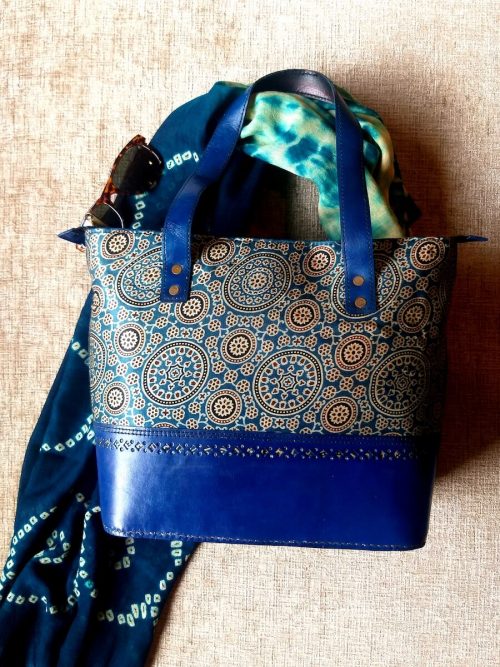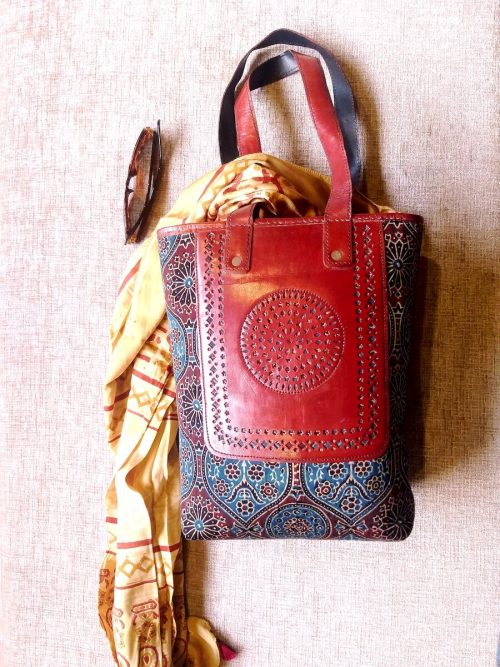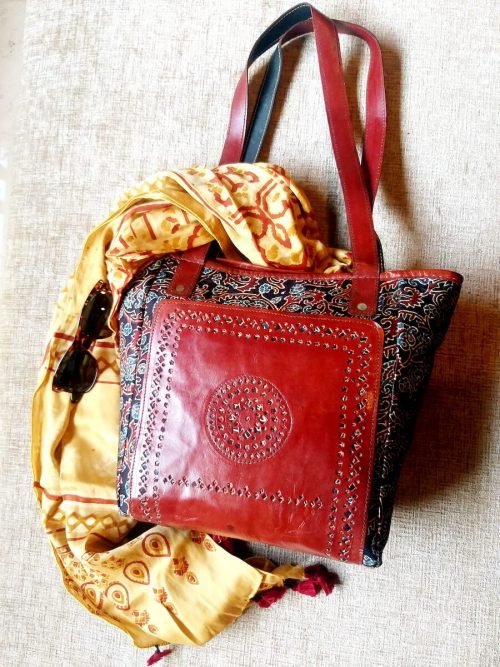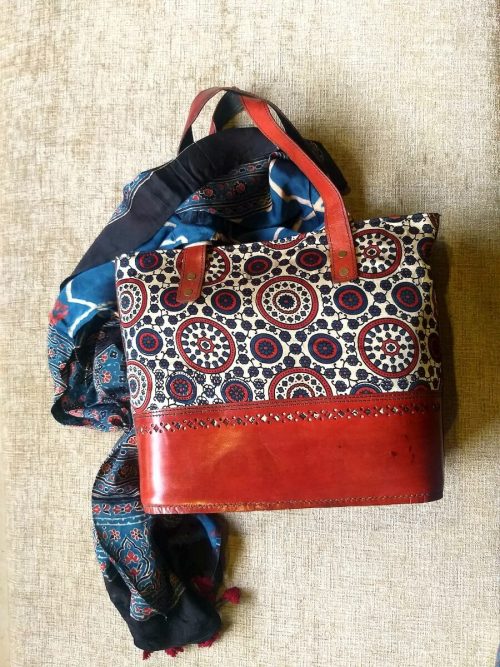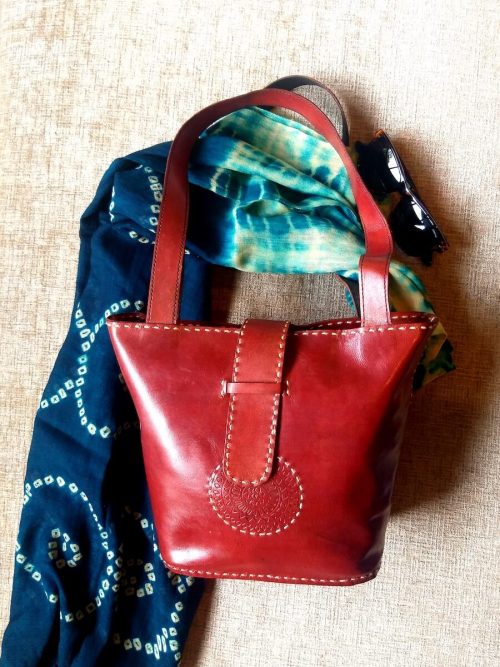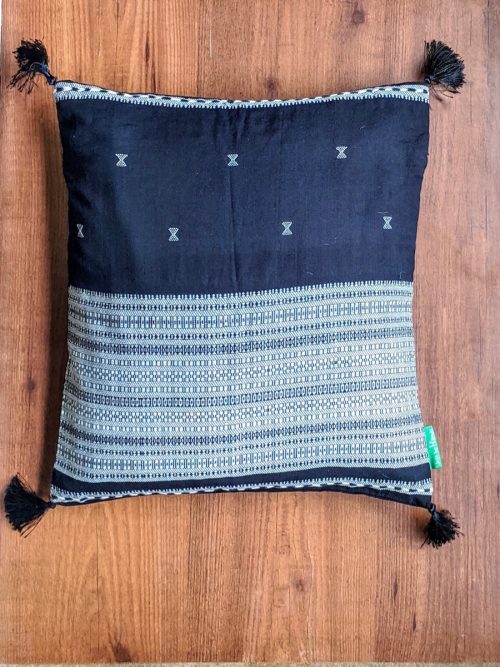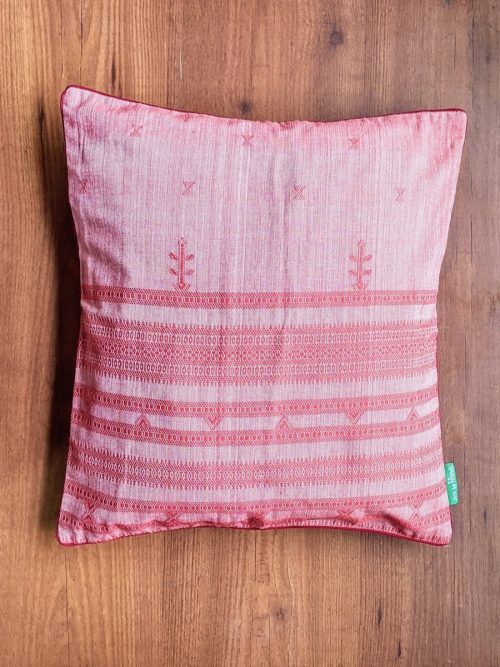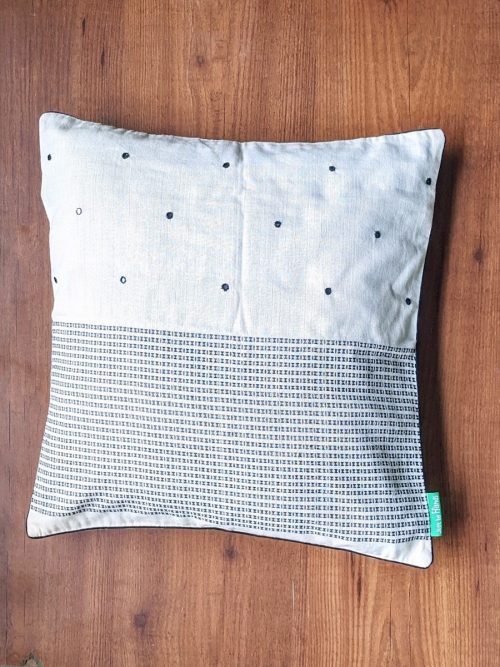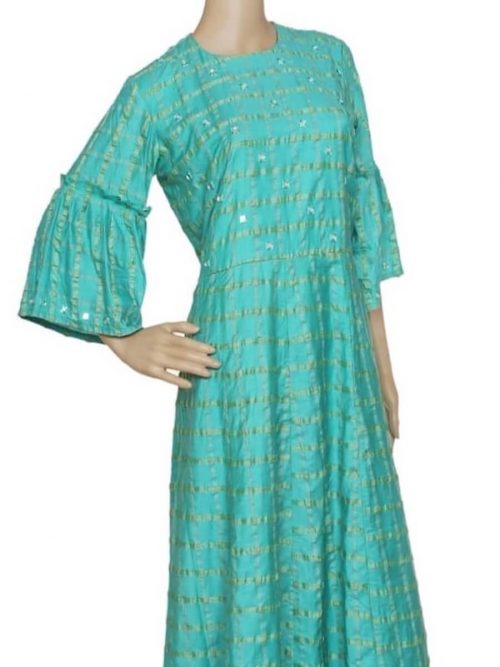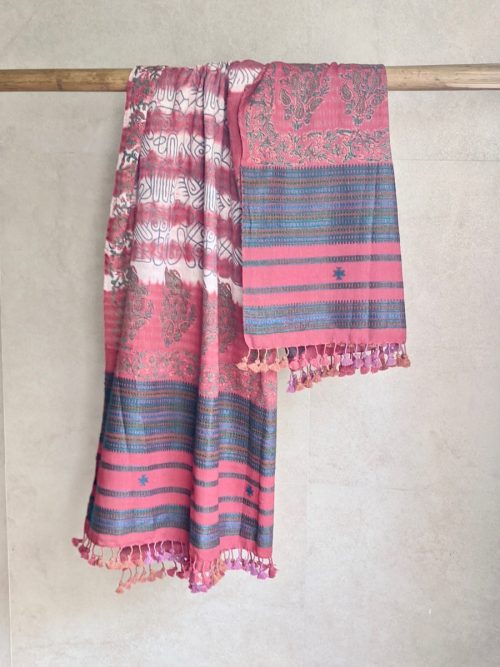| This bag is made from hand-processed leather. No chemicals are used in making this leather, even the dye used on leather in natural. The fabric used on the bag is Ajrakh silk. Ajrakh is a famous traditional block printing technique that is claimed to have originated in province of Sindh & Kutch. It is made using a long drawn process with many stages of dyeing, each stage individually taking days to finish. High level of skill & concentration is required to achieve final vivid prints. It may contain some irregularities and should not be seen as defects. Please do not over-fill your bag as it may lose its shape. Any water spills on the bag allow to dry naturally. Never use artificial heat. |
-
Compare
-
Compare
This bag is made from hand-processed leather. No chemicals are used in making this leather, even the dye used on leather in natural. The fabric used on the bag is Ajrakh silk. Ajrakh is a famous traditional block printing technique that is claimed to have originated in province of Sindh & Kutch. It is made using a long drawn process with many stages of dyeing, each stage individually taking days to finish. High level of skill & concentration is required to achieve final vivid prints. It may contain some irregularities and should not be seen as defects. Please do not over-fill your bag as it may lose its shape. Any water spills on the bag allow to dry naturally. Never use artificial heat. -
Compare
This bag is made from hand-processed leather. No chemicals are used in making this leather, even the dye used on leather in natural. The fabric used on the bag is Ajrakh silk. Ajrakh is a famous traditional block printing technique that is claimed to have originated in province of Sindh & Kutch. It is made using a long drawn process with many stages of dyeing, each stage individually taking days to finish. High level of skill & concentration is required to achieve final vivid prints. It may contain some irregularities and should not be seen as defects. Please do not over-fill your bag as it may lose its shape. Any water spills on the bag allow to dry naturally. Never use artificial heat. -
Compare
This bag is made from hand-processed leather. No chemicals are used in making this leather, even the dye used on leather in natural. The fabric used on the bag is Ajrakh silk. Ajrakh is a famous traditional block printing technique that is claimed to have originated in province of Sindh & Kutch. It is made using a long drawn process with many stages of dyeing, each stage individually taking days to finish. High level of skill & concentration is required to achieve final vivid prints. It may contain some irregularities and should not be seen as defects. Please do not over-fill your bag as it may lose its shape. Any water spills on the bag allow to dry naturally. Never use artificial heat. -
Compare
This bag is made from hand-processed leather. No chemicals are used in making this leather, even the dye used on leather in natural. The fabric used on the bag is Ajrakh silk. Ajrakh is a famous traditional block printing technique that is claimed to have originated in province of Sindh & Kutch. It is made using a long drawn process with many stages of dyeing, each stage individually taking days to finish. High level of skill & concentration is required to achieve final vivid prints. It may contain some irregularities and should not be seen as defects. Please do not over-fill your bag as it may lose its shape. Any water spills on the bag allow to dry naturally. Never use artificial heat. -
Compare
This bag is made from hand-processed leather. No chemicals are used in making this leather, even the dye used on leather in natural. The fabric used on the bag is Ajrakh silk. Ajrakh is a famous traditional block printing technique that is claimed to have originated in province of Sindh & Kutch. It is made using a long drawn process with many stages of dyeing, each stage individually taking days to finish. High level of skill & concentration is required to achieve final vivid prints. It may contain some irregularities and should not be seen as defects. Please do not over-fill your bag as it may lose its shape. Any water spills on the bag allow to dry naturally. Never use artificial heat. -
CompareIndia Has 95% of World’s Handwoven Fabric. Indian hand-woven fabrics have been known since time immemorial. The handloom experience (soft, comfortable and durable) is due to the human handling of the yarn in the weaving process. As a result, yarn and the fabric are much less stressed and damaged. Hand woven cotton is known for its breathability as compared to mill made cotton. This implies that it allows more air penetration making it cooler, softer and more absorbent. It keeps you cooler in summers and warm in winters. Handloom motifs and patterns cannot be replicated on power looms or in textile factories. Enjoy the magic of Handwoven! Thankyou for bringing a handmade story home! Handwoven cloth contains irregularities not usually present in industrially-produced cloth - a quality often considered desirable by fashion enthusiasts.
-
CompareWoven by hand on unpowered loom. This fabric is woven in the villages of Kutch. Skilled weavers bring their imagination on the fabric by running the bobbin between the threads of warp & weft going up and down, in and out. Weavers use extra weft method and weave classic and intricate motifs thereby enhancing the beauty of the product. A humble wooden handloom sustains many artisan families & each product is blessed by the weaver for long life of its end user. Handloom motifs and patterns cannot be replicated on power looms or in textile factories. Bring the handmade story home or gift to your loved ones!
-
CompareWoven by hand on unpowered loom. This fabric is woven in the villages of Kutch. Skilled weavers bring their imagination on the fabric by running the bobbin between the threads of warp & weft going up and down, in and out. Weavers use extra weft method and weave classic and intricate motifs thereby enhancing the beauty of the product. A humble wooden handloom sustains many artisan families & each product is blessed by the weaver for long life of its end user. Handloom motifs and patterns cannot be replicated on power looms or in textile factories. Bring the handmade story home or gift to your loved ones!
-
CompareWoven by hand on unpowered loom. This fabric is woven in the villages of Kutch. Skilled weavers bring their imagination on the fabric by running the bobbin between the threads of warp & weft going up and down, in and out. Weavers use extra weft method and weave classic and intricate motifs thereby enhancing the beauty of the product. A humble wooden handloom sustains many artisan families & each product is blessed by the weaver for long life of its end user. Handloom motifs and patterns cannot be replicated on power looms or in textile factories. Bring the handmade story home or gift to your loved ones!
-
CompareIndia Has 95% of World’s Handwoven Fabric. Indian hand-woven fabrics have been known since time immemorial. The handloom experience (soft, comfortable and durable) is due to the human handling of the yarn in the weaving process. As a result, yarn and the fabric are much less stressed and damaged. Hand woven cotton is known for its breathability as compared to mill made cotton. This implies that it allows more air penetration making it cooler, softer and more absorbent. It keeps you cooler in summers and warm in winters. Handloom motifs and patterns cannot be replicated on power looms or in textile factories. Enjoy the magic of Handwoven! Thankyou for bringing a handmade story home! Handwoven cloth contains irregularities not usually present in industrially-produced cloth - a quality often considered desirable by fashion enthusiasts.
-
Compare
Combination of 3 art forms are used on this dupatta. Handwoven with beautiful design on the border, tie-dye pattern to create waves and then hand bock printed to give intricate design all over. Hand woven cotton is known for its breathability as compared to mill made cotton. This implies that it allows more air penetration making it cooler, softer and more absorbent. It keeps you cooler in summers and warm in winters. Handloom motifs and patterns cannot be replicated on power looms or in textile factories.
